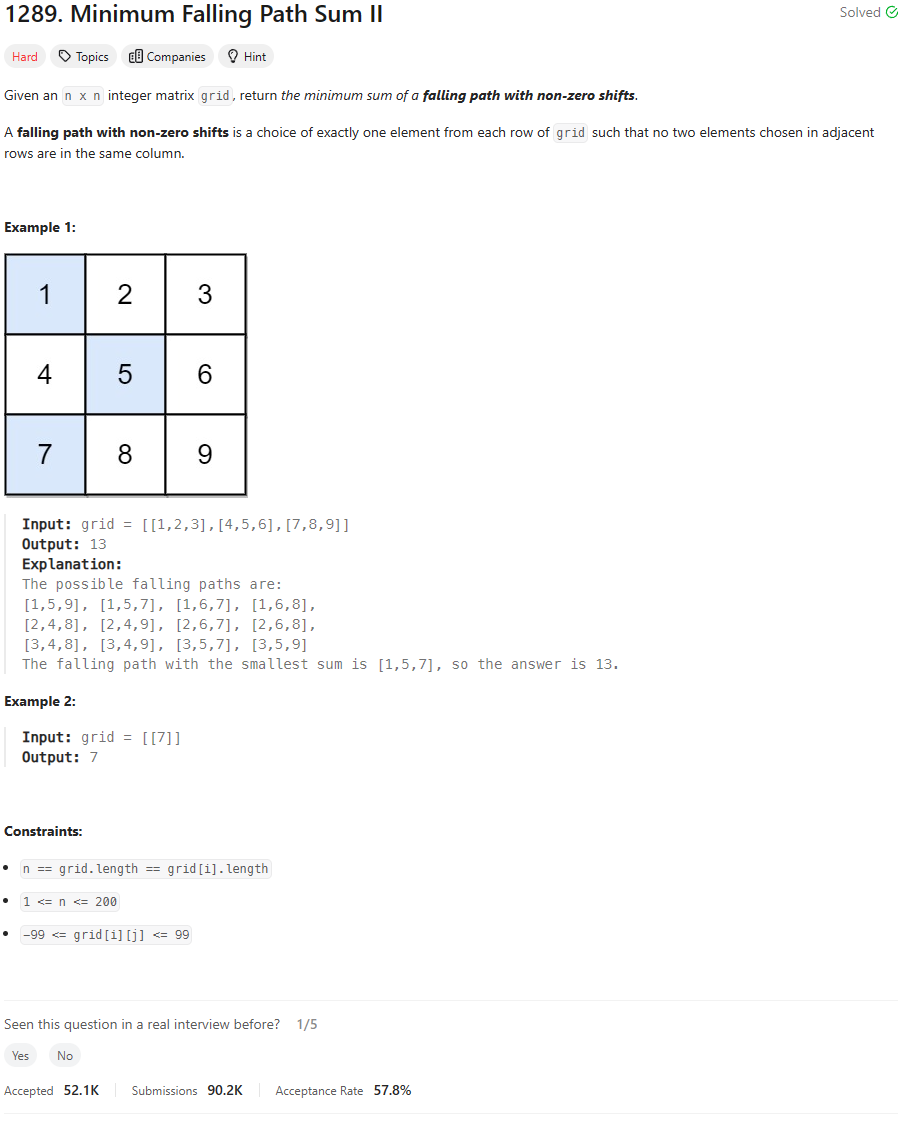Problem of The Day: Minimum Falling Path Sum II
Problem Statement

Notes:
- need to review this again
Topdown Memoization - TLE
class Solution:
def minFallingPathSum(self, grid: List[List[int]]) -> int:
N = len(grid)
res = float('inf')
@cache
def dfs(row, curr_sum, prev_col):
if row >= N:
return curr_sum
re = float('inf')
for col in range(N):
if col != prev_col:
re = min(re, dfs(row + 1, curr_sum + grid[row][col], col))
return re if re != float('inf') else curr_sum
return dfs(0, 0, N)
Editorial Solution
Approach 1: Top-Down Dynamic Programming
class Solution:
def minFallingPathSum(self, grid: List[List[int]]) -> int:
# Save the size of the square grid
n = len(grid)
# Initialize a hash map to cache the result of each sub-problem
memo = {}
# The optimal(row, col) function returns the minimum sum of a
# falling path with non-zero shifts, starting from grid[row][col]
def optimal(row, col):
# If the last row, then return the value of the cell itself
if row == n - 1:
return grid[row][col]
# If the result of this sub-problem is already cached
if (row, col) in memo:
return memo[(row, col)]
# Select grid[row][col], and move on to next row. For next
# row, choose the cell that leads to the minimum sum
next_minimum = inf
for next_row_col in range(n):
if next_row_col != col:
next_minimum = min(next_minimum, optimal(row + 1, next_row_col))
# Minimum cost from this cell
memo[(row, col)] = grid[row][col] + next_minimum
return memo[(row, col)]
# We can select any element from the first row. We will select
# the element which leads to minimum sum.
answer = inf
for col in range(n):
answer = min(answer, optimal(0, col))
# Return the minimum sum
return answer
Approach 2: Bottom-Up Dynamic Programming
class Solution:
def minFallingPathSum(self, grid: List[List[int]]) -> int:
# Save the size of the square grid
n = len(grid)
# Initialize a two-dimensional array to cache the result of each sub-problem
memo = [[inf] * n for _ in range(n)]
# Fill the base case
for col in range(n):
memo[n - 1][col] = grid[n - 1][col]
# Fill the recursive cases
for row in range(n - 2, -1, -1):
for col in range(n):
# Select minimum from valid cells of the next row
next_minimum = inf
for next_row_col in range(n):
if next_row_col != col:
next_minimum = min(next_minimum, memo[row + 1][next_row_col])
# Minimum cost from this cell
memo[row][col] = grid[row][col] + next_minimum
# Find the minimum from the first row
answer = inf
for col in range(n):
answer = min(answer, memo[0][col])
# Return the answer
return answer